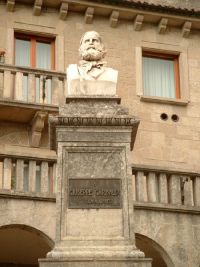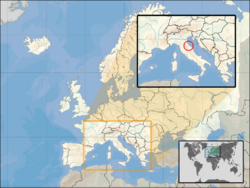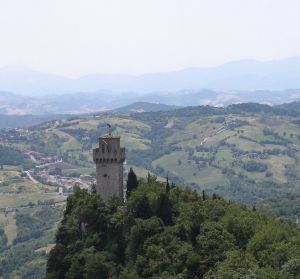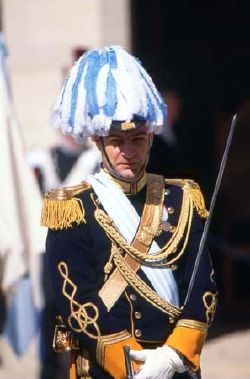San Marino
| Serenissima Repubblica di San Marino Most Serene Republic of San Marino | |||||
| |||||
| Motto: Libertas (Latin) "Liberty" | |||||
| Anthem: "Inno Nazionale della Repubblica" | |||||
| Capital | San Marino 43°56′N 12°27′E | ||||
|---|---|---|---|---|---|
| Largest city | Serravalle | ||||
| Official languages | Italian1 | ||||
| Government | Republic | ||||
| - Captains Regent | Alessandro Mancini Alessandro Rossi | ||||
| Foundation | |||||
| - Date | September 3 301 | ||||
| Area | |||||
| - Total | 61 km² (223rd) 23.5 sq mi | ||||
| - Water (%) | negligible | ||||
| Population | |||||
| - January 2005 estimate | 28,117 | ||||
| - Density | 481/km² 1,225/sq mi | ||||
| GDP (PPP) | 2001 estimate | ||||
| - Total | $904 million | ||||
| - Per capita | $34,600 | ||||
| HDI (2003) | n/a (unranked) | ||||
| Currency | Euro (€) (EUR)
| ||||
| Time zone | CET (UTC+1) | ||||
| - Summer (DST) | CEST (UTC+2) | ||||
| Internet TLD | .sm | ||||
| Calling code | +378 | ||||
| 1 SAN MARINO. UNECE. | |||||
The Most Serene Republic of San Marino (Italian: Serenissima Repubblica di San Marino) is a country in the Apennine Mountains. It is a landlocked enclave, completely surrounded by Italy. One of the European microstates, San Marino has the smallest population of all the members of the Council of Europe.
According to tradition, San Marino is the oldest constitutional republic in the world still existing: it was founded on September 3 in the year 301 by Marinus of Rab, a Christian stonemason fleeing the religious persecution of Roman Emperor Diocletian. San Marino has the oldest written constitution still in effect, dating back to 1600.[1]
History
According to tradition, Marino left the Adriatic island of Rab (Italian: Arbe) with his lifelong friend Leo and went to the town of Rimini as a stone worker. After persecution because of his Christian sermons, he escaped to the nearby Monte Titano, where he built a small church and thus founded what is now the city and the state of San Marino. The official date of foundation of the Republic is 3 September 301.
By the mid-5th century, a community was formed; because of its relatively inaccessible location and its poverty, it has succeeded, with a few brief interruptions, in maintaining its independence. In 1631 its independence was recognized by the papacy.

During the early phase of the Italian unification process of the 19th century, San Marino served as a haven of refuge for numerous persons who were persecuted because of their support for Italian unification. In memory of this support, Giuseppe Garibaldi accepted the wish of San Marino not to be incorporated into the new Italian state. Napoleon refused to take the country. He commented, "Why, it's a model republic!"
The government of San Marino made United States President Abraham Lincoln an honorary citizen. He wrote in reply, saying that the republic proved that "government founded on republican principles is capable of being so administered as to be secure and enduring."[2]
During World War II Axis forces retreated through the country and were pursued by the American and British forces. The Allied troops left the country a few weeks later.
The head of state is a committee (council) of two captains-regent. San Marino also holds the record for the world's first democratically-elected communist government, which held office between 1945 and 1957.
San Marino was the world's smallest republic from 301 to 1968, until Nauru gained independence.
San Marino became a member of the Council of Europe in 1988 and of the United Nations in 1992. It is not a member of the European Union.
Geography
San Marino is an enclave in Italy, on the border between the regioni of Emilia Romagna and Marche. Its topography is dominated by the Apennines mountain range, and it has a rugged terrain. The highest point in the country, Monte Titano, is situated at 749 metres (2,457 ft) above sea level. There are no bodies of water of any significant size.
The climate is Mediterranean, with warm summers and mild winters.
San Marino is the third-smallest country in Europe, with only Vatican City and Monaco being smaller.
Municipalities
San Marino is divided into the following nine municipalities, known locally as castelli or castles (sing. castello, each on a different hill, as depicted on the republic's coat of arms), that are also towns to the world.
- The City of San Marino (Città di San Marino) is the eponymous capital. There are also eight minor municipalities:
- Acquaviva
- Borgo Maggiore
- Chiesanuova
- Domagnano
- Faetano
- Fiorentino
- Montegiardino
- Serravalle
The largest town of the Republic is Dogana, which is not an autonomous castello but rather belongs to the castello of Serravalle.
Each castello, like Italian comuni, includes a main town that is the seat of the castello, called capoluogo, and some even smaller localities known as frazioni.
Politics
The Politics of San Marino takes place in a framework of a parliamentary representative democratic republic, whereby the Captains Regent are the heads of state, and of a pluriform multi-party system. Executive power is exercised by the government. Legislative power is vested in both the government and the Grand and General Council. The judiciary is independent of the executive and the legislature.
San Marino was originally led by the Arengo, initially formed with the heads of each family. In the 13th century, power was given to the Great and General Council. In 1243, the first two Captains Regent were nominated by the Council. This method of nomination is still in use today, as of 2007.
The legislature of the republic is the Grand and General Council (Consiglio grande e generale). The Council is a unicameral legislature which has 60 members with elections occurring every 5 years under a proportional representation system in all nine administrative districts. These districts (townships) correspond to the old parishes of the republic. Citizens eighteen years or older are eligible to vote. Besides general legislation, the Grand and General Council approves the budget and elects the Captains Regent, the State Congress (composed of 10 Secretaries with executive power), the Council of Twelve (which forms the judicial branch during the period of legislature of the Council), the Advising Commissions, and the Government Unions. The Council also has the power to ratify treaties with other countries. The Council is divided into five different Advising Commissions consisting of 15 councilors which examine, propose, and discuss the implementation of new laws that are on their way to being presented on the floor of the Council.
Every 6 months, the Council elects two Captains Regent to be the heads of state. The Regents are chosen from opposing parties so there is a balance of power. They serve a 6-month term. The investiture of the Captains Regent takes place on April 1 and October 1 in every year. Once this term is over, citizens have 3 days in which to file complaints about the Captains' activities. If they warrant it, judicial proceedings against the ex-head(s) of state can be initiated.
The practice of dual heads of state, as well as the frequent re-election of same, are derived directly from the customs of the Roman Republic. The Council is equivalent to the Roman Senate; the Captains Regent, to the consuls of ancient Rome.
San Marino is a multi-party democratic republic. The two main parties are the Democratic Christian Party of San Marino (PDCS) and the Party of Socialists and Democrats (PSD, a merger of the Socialist Party of San Marino and the Party of Democrats) in addition to several other smaller parties. Due to the small size of San Marino and its low population, it is difficult for any party to gain a pure majority and most of the time the government is run by a coalition. As a result of the June 2001 election, the PDCS and PSS control a majority of seats in the Council.
Economy
Although San Marino is not an official European Union member, it is allowed to use the euro as its currency by virtue of arrangements with the council of the European Union; it is also granted the right to use its own designs on the national side of the euro coins. Before the Euro, the Sammarinese lira was coupled to and exchangeable with the Italian lira. The small number of Sammarinese euro coins, as was the case with the lira before it, are primarily of interest to coin collectors.
The tourist sector contributes over 50% of San Marino's GDP, with more than 3.3 million tourists visiting in 1997. Other key industries are banking, electronics, and ceramics. The main agricultural products are wine and cheese.
San Marino's postage stamps, which are only valid for mail posted within the country, are mostly sold to philatelists and also form a source of income. San Marino is a member of the Small European Postal Administration Cooperation.
The per capita level of output and standard of living are comparable to those of Italy, which supplies much of its food.
Taxation
The corporate profits tax rate in San Marino is 19 percent. Capital gains are subject to a five percent tax; interest is subject to a 13 percent withholding tax.
In 1972, a valued added taxation (VAT) system was introduced in Italy, and was applied in San Marino, in accordance with the 1939 friendship treaty. In addition, a tax on imported goods, to be levied by San Marino, was established. Such taxes, however, were not, and are not, applied to national products. Until 1996, goods manufactured and sold in San Marino were not subject to indirect taxation.
Under the European Union customs agreement, San Marino continues to levy taxes, the equivalent of an import duty, on imported goods. Also, a general VAT was introduced, in replacement of the Italian VAT.
Demographics
There is no significant difference between the demographics of San Marino and Italy.
The state has a population of approximately 29,000, including 1,000 foreigners, most of whom are Italians. About 5,000 Sammarinese live in foreign countries, predominantly in Italy.
The language spoken is Italian, with the Emiliano-Romagnolo dialect, and Roman Catholicism is the predominant religion.
Military
San Marino has one of the smallest military forces in the world. Its different branches have varied functions including: performing ceremonial duties; patrolling borders; mounting guard at government buildings; and assisting police in major criminal cases.
Although once at the heart of San Marino's army, the Crossbow Corps is now an entirely ceremonial force of about 80 volunteer soldiers. The Crossbow Corps since 1295 has provided demonstrations of crossbow shooting at festivals. Its uniform is mediaeval in design, and although it is a statutory military unit, it has no actual military function today.
The Guard of the Rock is a front-line military unit in the San Marino armed forces, a state border patrol, with responsibility for patrolling borders and defending them. In their role as Fortress Guards they are also responsible for the guarding of the Palazzo Pubblico in San Marino City, which is the seat of national Government. In this role they are the forces most visible to tourists, and known for their colourful ceremony of Changing the Guard. Under the 1987 statute the Guard of the Rock are all enrolled as 'Criminal Police Officers' (in addition to their military role) and act to assist the police in investigating major crime. The uniform of the Guard of the Rock is distinctively red and green in color.
The Guard of the Council Great and General commonly known as The Guard of the Council or locally as the 'Guard of Nobles', formed in 1740, are a volunteer unit with ceremonial duties. Due to its striking blue white and gold uniform, it is perhaps the most well-known part of the Sammarinese military, and appears on countless postcard views of the republic. The functions of the Guard of the Council are to protect the Captains Regent, and to defend the Great and General Council during its formal sessions. They also provide a ceremonal bodyguard to government officials on festivals of both state and church.
There is also a Gendarmerie which is technically part of the military forces of the republic. The entire military corps of San Marino depends upon the co-operation of full-time forces and their retained (volunteer) colleagues, known as the Corpi Militari Volontari, or Voluntary Military Force. National defence in the face of an aggressive world power is, by arrangement, the responsibility of Italy's armed forces.
Transport
San Marino's railway network consisted of a single line, connecting the country with the Italian rail network at Rimini. Unable to access the capital, San Marino City (which has a mountain-top location), the terminus station was located at the village of Valdragone. The railway was opened on 12 June 1932.[3]
It was an advanced system for its time, being an electric railway, powered by overhead electric cables. The trains drew power from these cables by means of a pantograph system. The railway was well built and well used, and in all probability would have been a long-term feature of Sammarinese public transport, but it was almost completely destroyed during the fighting in this region during World War II. Today there is no operational railway in San Marino.
There is a 1.5 km aerial tramway connecting the city of San Marino on top of Monte Titano with Borgo Maggiore, a major town in the republic, with the second largest population of any Sammarinese settlement. Indeed, for the tourist visitor the aerial tramway gives the best available views of Borgo Maggiore, as the cars sweep low over the rooftops of the main town square. From here a further connection is available to the nation's largest settlement, Dogana, by means of local bus service.
Two aerial tramway cars, known as gondolas, and numbered '1' and '2', operate in opposition on a cable, and a service is provided at roughly fifteen minute intervals throughout the day. A third vehicle is available on the system, being a service car for the use of engineers maintaining the tramway.
There are 220 km of highways in the country, the main road being the San Marino Superhighway. Roads are well used by private car drivers. Sammarinese authorities license private vehicles with distinctive licence plates which are white with blue figures with the coat of arms, usually a letter followed by up to four numbers. Many vehicles also carry the international vehicle identification code (in black on a white oval sticker), which is "RSM".
A limited licensed taxi service operates nationwide. There are seven licensed taxi operating companies in the republic[4], and Italian taxis regularly operate within San Marino when carrying passengers picked up in Italian territory.
There is a regular bus service between Rimini and the city of San Marino, popular with both tourists and tourist industry workers commuting to San Marino from Italy. This service stops at approximately twenty advertised locations in Rimini and within San Marino, with its two terminus stops at Rimini railway station and San Marino coach station, respectively.
There are no airports in San Marino, but there is an international heliport located in Borgo Maggiore. Most tourists who arrive by air land at Federico Fellini International Airport close to the city of Rimini and then make the transfer by bus.
Two rivers flow through San Marino, but there is no major water transport, and no major port or harbour.
Culture
The Three Towers of San Marino are located on the three peaks of Monte Titano in the capital. They are depicted on both the Flag of San Marino and its coat of arms. The three towers are: Guaita, the oldest of the three (it was constructed in the eleventh century); the thirteenth-century Cesta, located on the highest of Monte Titano's summits; and the fourteenth-century Montale, on the smallest of Monte Titano's summits, still privately owned.
San Marino has a famous cake known as La Torta Di Tre Monti ("Cake of the Three Mountains/Towers"), similar to a layered wafer cake covered in Chocolate.
Sport
San Marino, along with Italy, enjoys football (soccer) as its most popular sport.
The San Marino Championship, founded under the auspices of the FSGC (San Marino Football Federation), is the premier footballing competition in San Marino. The fifteen teams that take part in the competition are split into two groups of eight and seven teams. The top three from each section at the end of the regular season progress into a semi-knockout style Championship Playoff. Prior to 2007, the playoff champion earned a spot in the preliminary rounds of the UEFA Cup. In 2007, UEFA granted San Marino a spot in the 1st Qualifying Round of the Champions League. 2007 league champions S.S. Murata was the first team to represent San Marino in the Champions League when they participated in the 2007-08 competition, losing to Finland's Tampere team. San Marino also has a representative in the Italian system, with San Marino Calcio playing in the third tier of Italian football, Serie C2/B. San Marino play their home matches in the Sanmarinese at the Stadio Olimpico of Serravalle.
The San Marino national team played its first unofficial international match in 1986, in which it suffered a 0-1 defeat to the Canadian Olympic team. Its first competitive outing was on November 14, 1990, a 0-4 loss against Switzerland in the European Championship qualifier. These defeats set the tone for most of the following outings of the team, who are regarded as whipping boys in the qualifying sections of the European Championship and the World Cup.
They had a brief moment of glory when they faced England in a World Cup qualifier on November 17, 1993 and took the lead through David Gualtieri after just 8.3 seconds - still the fastest goal in World Cup competition [1]. Despite this goal, only San Marino's third at international level, the microstate went on to lose 7-1.
Until recently, San Marino's international record was one of almost total failure, with famous draws against Turkey and Latvia being the only partial successes in an international career that contains over 70 defeats. However, on the 29 April 2004, San Marino recorded their first ever win, with a 1-0 victory over Liechtenstein in an international friendly. Andy Selva scored the only goal in a close game that finally gave this tiny republic a footballing victory.
On September 6, 2006, San Marino suffered their biggest ever defeat, losing 13-0 to world giants Germany in the Stadio Olimpico. It was also the largest goal margin defeat in European Championship Qualifying history. In the same competition on February 7th 2007, they came within 8 seconds of the best result in their history. They were level at 1-1 with the Republic of Ireland after 94 minutes when Stephen Ireland scored within 8 seconds of the final whistle. The goal scored by San Marino was their European Qualifying first goal since losing 4-1 to Austria in 1998.
As of May 2007, San Marino is 195th in the FIFA world rankings.
One of the Formula One races, the San Marino Grand Prix, is named after the state, although it does not actually take place there. It takes place at the Autodromo Enzo e Dino Ferrari in the Italian town of Imola, about 100 km northwest of San Marino, along the Via Emilia. The race was etched in infamy after two fatal accidents occurred at the 1994 Grand Prix, when Ayrton Senna and Roland Ratzenberger were killed.
The race was removed from the calendar for 2007.
San Marino has a rather successful professional baseball team, T & A San Marino, which play in the top division of Italian professional baseball, the Serie A1. It has participated in the European Cup tournament for the top European professional baseball teams several times, hosting the event in 1996, 2000 and 2004, and scheduled to host in 2007. It won the championship in 2006.
Music of San Marino
See Music of San Marino.
Miscellaneous topics
- Communications in San Marino
- Foreign relations of San Marino
- Tourism in San Marino
- San Marino Grand Prix
- Related: Autodromo Enzo e Dino Ferrari, the circuit that hosts the San Marino Grand Prix
- Associazione Guide Esploratori Cattolici Sammarinesi
ReferencesISBN links support NWE through referral fees
- ↑ Law Library of United States Congress. Guide to Law Online: San Marino. Retrieved 2007-03-29.
- ↑ Irving Wallace, The Book of Lists 3
- ↑ See page 85 of this on-line PDF magazine for full details. No English translation is currently available - can you help?.
- ↑ Licensed taxi companies are listed on the Government tourism website.
External links
- Travel guide to San Marino from Wikitravel
- CIA World Factbook: San Marino
- {{{2}}} at the Open Directory Project
- Musei di Stato della Repubblica di San Marino
- (Italian) Secretary of State for External Relations and Politics
- History of San Marino: Primary Documents
- Visit San Marino - Official San Marino Tourism Site Contrada Omagnano
- (Italian) General information of San Marino: Politics, Institutions and very other
- San Marino: excerpt from a 1769 Guidebook
Albania · Andorra · Armenia2 · Austria · Azerbaijan1 · Belarus · Belgium · Bosnia and Herzegovina · Bulgaria · Croatia · Cyprus2 · Czech Republic · Denmark3 · Estonia · Finland · France3 · Georgia1 · Germany · Greece · Hungary · Iceland · Ireland · Italy · Kazakhstan1 · Latvia · Liechtenstein · Lithuania · Luxembourg · Republic of Macedonia · Malta · Moldova · Monaco · Montenegro · Netherlands3 · Norway3 · Poland · Portugal · Romania · Russia1 · San Marino · Serbia · Slovakia · Slovenia · Spain3 · Sweden · Switzerland · Turkey1 · Ukraine · United Kingdom3 · Vatican City
1 Has majority of its territory in Asia. 2 Entirely in Asia but having socio-political connections with Europe. 3 Has dependencies or similar territories outside Europe.
Andorra · Angola · Argentina · Bolivia · Brazil · Cape Verde · Chile · Colombia · Costa Rica · Côte d'Ivoire · Cuba · Dominican Republic · Ecuador · El Salvador · France · Guatemala · Guinea-Bissau · Haiti · Holy See · Honduras · Italy · Mexico · Moldova · Monaco · Mozambique · Nicaragua · Panama · Paraguay · Peru · Philippines · Portugal · Romania · San Marino · São Tomé and Príncipe · Senegal · Sovereign Military Order of Malta · Spain · Timor-Leste · Uruguay · Venezuela
Template:Latin Europe
Credits
New World Encyclopedia writers and editors rewrote and completed the Wikipedia article in accordance with New World Encyclopedia standards. This article abides by terms of the Creative Commons CC-by-sa 3.0 License (CC-by-sa), which may be used and disseminated with proper attribution. Credit is due under the terms of this license that can reference both the New World Encyclopedia contributors and the selfless volunteer contributors of the Wikimedia Foundation. To cite this article click here for a list of acceptable citing formats.The history of earlier contributions by wikipedians is accessible to researchers here:
The history of this article since it was imported to New World Encyclopedia:
Note: Some restrictions may apply to use of individual images which are separately licensed.












